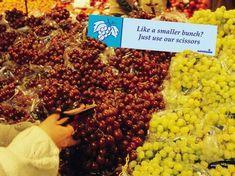
Apples, oranges and bananas may still dominate Irish shopping lists, but a new consumer favourite is emerging - grapes.
The retail market for grapes in the Irish Republic is now worth over €40 million a year and growing at “an exceptional rate”, according to the trade. Grapes account for 11 per cent of all Irish retail fruit sales, up from eight per cent last year, and a spokesman for the Musgrave Group, one of the major players in the Irish market, predicted that its sales could soon overtake those of bananas, a long-time favourite.
Padraig Byrne, fruit buyer with Musgrave, owner of the SuperValu and Centra franchises, offers figures to back up his forecast. The group’s total grape sales for the year are expected to be €10.75m, compared to €12m for bananas, but the figure for grapes represents an annual growth of 27 per cent.
Even more remarkable, he estimates the sales growth in prepacked grapes at 35 per cent. “Grape sales are growing strongly,” he says, “with prepacked selling at twice the rate of loose. Grapes are not quite as big as bananas but will probably overtake them next year if current growth rates are sustained.”
Elsewhere, the story is the same. The particular favourite with Irish consumers, and the biggest seller, is pre-packed seedless.
At Superquinn, which has 21 stores across the Republic, fruit buyer Brian Kelly acknowledges that seeded grapes are being phased out, with low-price packs on offer only at special times like Halloween.
“We try to give customers what they want,” he says, “and it’s obvious they don’t want the trouble of having to dispose of pips every time they eat a grape, even if the seeded variety is cheaper. Similarly, they like grapes prepacked for reasons of hygiene, the feeling that they haven’t been touched by human hand, and convenience, of course.
“Filling up a bag with loose grapes and then having to wait to have them weighed at the checkout is regarded as something of a chore these days.”
Various reasons are advanced to explain Ireland’s blossoming love affair with the grape. There is the country’s new found prosperity, generated by the Celtic Tiger economic boom, with a six per cent growth rate, the highest in the EU, more foreign holidays, higher expectations, more exotic tastes. A more likely explanation is the new emphasis on fresh fruit in the health and fitness fight, with grapes the most palatable and, according to some experts, the most beneficial.
As with all imports, the growing consumer demand creates its own problems and pressures in ensuring an all-year-round supply to retail outlets. There are three main importers, Fyffes, Keelings and Donnellys, though some of the multiples, like Superquinn, for instance, sometimes bring in their own supplies from Europe.
South Africa is Ireland’s largest supplier, but grapes are also imported from Chile and Brazil, as well as California, with “a small quantity” coming from Mexico. Israel is another country on the importers’ list, while in Europe, Spain, Greece and Italy are the main sources of supply.
Given the Irish consumer view that eating grapes should not involve having to dispose of the pips, it is hardly surprising that the main variety being imported is Thompson Seedless. But Flame Seedless and Sugraone, a variety closely identified in Ireland with Mexico, are also available.
Importers generally favour medium-term contracts in a bid to ensure stability in price and supply. But occasionally, if harvests are in difficulty in South Africa or Chile, due to drought or other problems, and a seasonal shortage is created, there can be “a mad scramble” across world markets to try to fill orders, according to Superquinn’s Kelly. “Remember,” he says, “we’re expected to have grapes available 52 weeks of the year and that can be difficult, sometimes.”
Once regarded in Ireland as a luxury item, grapes are now as common in children’s lunch boxes as bread and cheese. Retail sales are soaring and consumption high, though critics are quick to point out that, comparatively speaking, the Irish consumption rate lags far behind that of the traditional grape producing countries of continental Europe.
That may be so. But, as the retail figures show, the Irish are in hot pursuit. And savouring every juicy moment of it.



